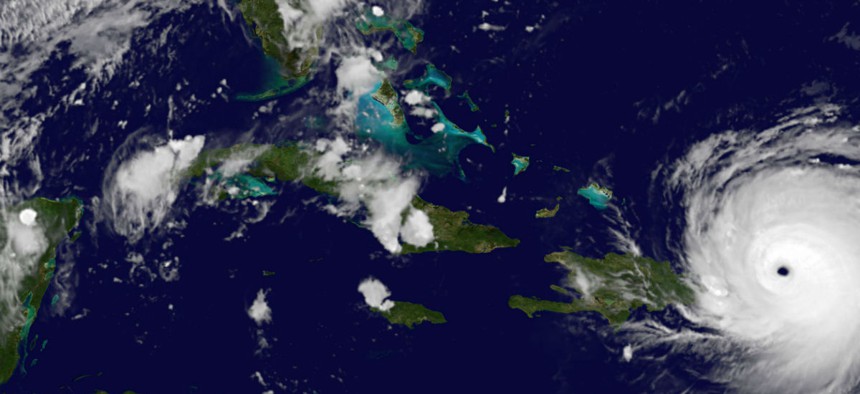
NASA/NOAA GOES Project via AP
More than 32,000 Feds Are Responding to Hurricanes Harvey and Irma
Agencies across the government have pitched in on federal response and recovery efforts to disasters on two fronts.
As floodwaters from Hurricane Harvey recede and Hurricane Irma barrels toward the Florida coast, agencies across the government have engaged more than 32,000 federal employees in the two-fronted response to the storms.
Thousands of federal workers aided in rescue and recovery efforts while Harvey tore across Texas and Louisiana, and the numbers have only increased since the skies cleared. More than 30,000 government employees are currently working to support a range of recovery efforts in the wake of the storm, a Federal Emergency Management Agency spokesperson told Government Executive.
Agencies have stationed an additional 2,600 employees throughout the southeast and U.S. territories in the Caribbean in preparation for Hurricane Irma, a Category 5 storm that’s already devastated Puerto Rico and the U.S. Virgin Islands. The federal presence will increase significantly if the storm makes landfall in Florida on Sunday as expected.
Here’s a look at how agencies have contributed resources and personnel in the two disaster zones so far:
Federal Emergency Management Agency: As the agency leading federal disaster response efforts, FEMA has more than 5,000 employees supporting the Harvey response in Texas and Louisiana and more than 1,000 working to prepare for Irma, according to an agency spokesperson. The two-front effort includes employees in the agency’s D.C. command center and local offices in Denton, Texas; Atlanta; Philadelphia; and New York. Irma responders are stationed throughout the Caribbean to aid survivors in the wake of the storm. As of Thursday morning, the agency had millions of liters of water and meals, as well as cots, blankets, generators and other equipment prepositioned at bases in Alabama. FEMA has also begun hiring local workers to temporarily assist with recovery efforts in Texas. The agency plans to hire 400 to 500 employees in the coming weeks, a spokesperson said, with some beginning work on Monday.
Homeland Security Department: As FEMA’s parent agency, DHS activated its Surge Capacity Force on Aug. 28 to supplement FEMA workers on the ground. As of Wednesday, DHS had deployed 937 employees as part of the Harvey response efforts, a spokesperson told Government Executive. The DHS response includes employees from agency headquarters as well as a number of sub-agencies: the Transportation Security Administration, U.S. Citizenship and Immigration Services, Customs and Border Protection, the U.S. Coast Guard, U.S. Immigration and Customs Enforcement, Federal Law Enforcement Training Centers, and the U.S. Secret Service.
Transportation Security Administration: TSA specifically plans to deploy roughly 250 employees to Florida to assist with airport security after Irma cuts through the region. TSA personnel based everywhere from Boston to San Diego are stationed at airports in the Southeast to wait out the storm. In addition to the 500 TSA volunteers working as part of FEMA’s Surge Capacity Force, about 200 are supporting local and federal efforts on the ground in Texas.
Health and Human Services Department: At the height of its Harvey response, HHS had deployed more than 1,000 employees throughout Texas and Louisiana to aid public health efforts on the ground. HHS Secretary Tom Price declared a public health emergency in Texas, giving teams on the ground more flexibility in meeting the various needs of victims. The agency has since partnered with local medical groups to support social services and health initiatives in the wake of the storm, providing medical equipment, temporary care centers, shelters and other resources. HHS has already deployed medical teams and supplies to Puerto Rico and Georgia in preparation for the Hurricane Irma response, according to an agency spokesperson. Price declared public health emergencies in the U.S. Virgin Islands and Puerto Rico after Irma ripped across both U.S. territories, as well as in Florida leading up to the storm.
Agriculture Department: USDA has made food more accessible to Harvey victims by waiving some regulations in Texas and supporting the Salvation Army in providing free meals. The agency is also providing food to Texas schools serving as shelters and disaster organizations, and offering free meals to students in schools affected by the storm.
Environmental Protection Agency: The EPA is supporting local, state and federal efforts to monitor public water systems and waste sites impacted by Harvey. The storm hit 13 Superfund sites, areas designated by the EPA as the most toxic sites in the country. As of Tuesday, the EPA reported that 11 of the sites were still inaccessible, and had yet to be assessed for damage. The agency has already begun securing 22 Superfund sites in southern Florida in advance of Hurricane Irma. EPA said it plans to monitor the storm’s path and alert local authorities if any sites begin to threaten people in the area.
Veterans Affairs Department: VA has sent a number of resources to the Harvey disaster area to assist veterans affected by the storm. The agency deployed five mobile medical care units to provide veterans and their families with primary care, mental health services and other resources, and also set up a mobile pharmacy in Houston to aid veterans in need of medications.
Federal Aviation Administration: In response to Harvey, FAA air traffic controllers in Houston and Galveston, Texas, worked around the clock to coordinate humanitarian flights bringing relief supplies into the disaster zone as well as search and rescue missions flown by the military, FEMA, Coast Guard and others, said Doug Church, director of communications at the National Air Traffic Controllers Association. Church told Government Executive that air traffic control facilities in the Southeast are already managing efforts to move aircraft and evacuees out of Hurricane Irma’s path. Facilities in Florida and the surrounding region are also working on plans to staff airports during Irma and immediately coordinate relief efforts once the storm passes, he said.
This article has been updated to include information from the FAA.







